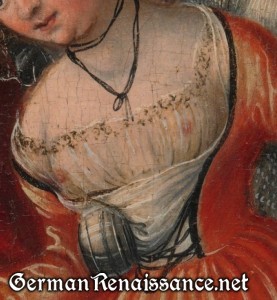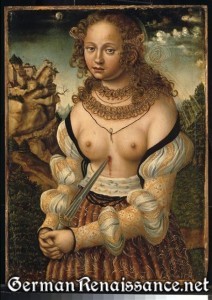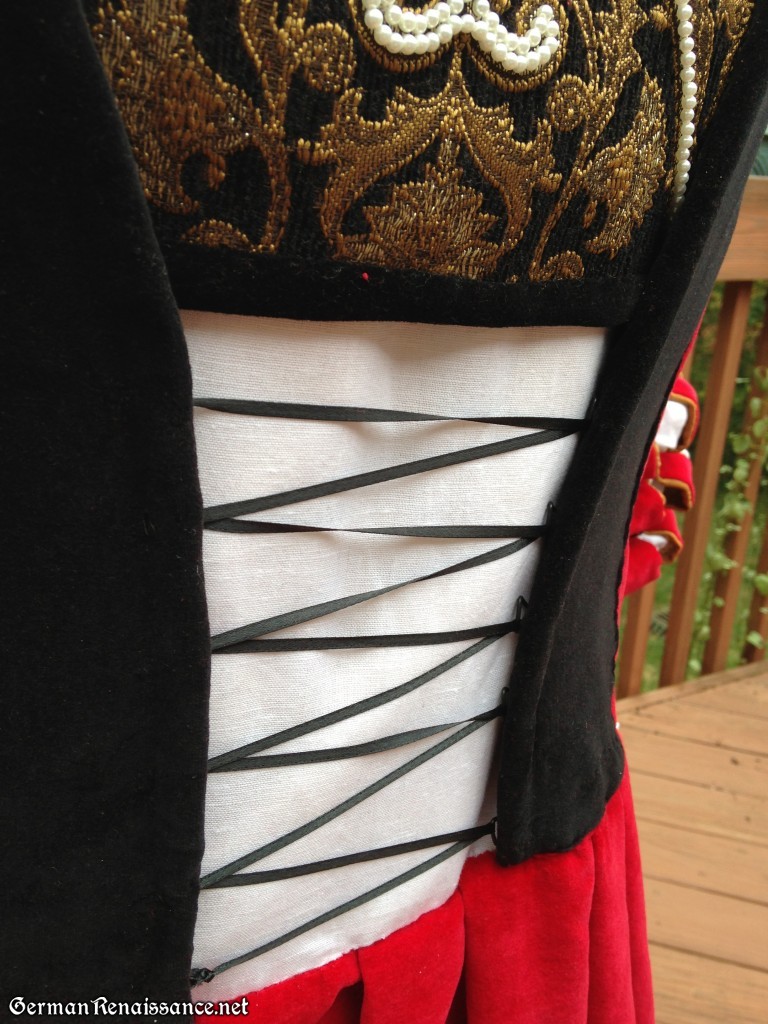German Saxon court gowns of the first half of the 16th century, made famous by painter Lucas Cranach’s ladies, have one particularly defining feature: a plastron (brustfleck) with a decorative band at the top and a laced-over bottom (usually white, but not always).
I’ve been studying this style for more than a year, trying to work out the construction. After looking at many, many portraits, woodcuts, and photos of reconstructions by other enthusiasts like me, I’ve come to some preliminary conclusions:
1. The brustfleck is sewn, pinned, or hooked into the sides of the bodice.
2. The white material at the bottom seen below the brustfleck is probably distinct from whatever hemd, kirtle, or underdress, and may or may not be attached to the decorative band at the top. I usually do not see any wrinkles in the white section that would lead me to believe it was just a hemd. It appears that the simpler, lower class gowns of this design are more likely to show the wrinkles, and the fancier, court gowns do not.
3. No boning was used; rather canvas and possibly a flexible buckram was used to stiffen it. The brustfleck definitely seems to curve. Plus we have no evidence that boning was used at this point and place in time.
I draw these conclusions from several images I found of women in various states of undress.
In the above detail image, we can see a woman with her dress partly undone. The main interest for me here is the rectangular piece hanging off her right side. It looks to me like it could be the backside of a brustfleck. [Nope, that looks like the armored hand of the man holding her, which you can see if you click on the image.] Also note she is wearing a very diaphanous hemd as well as a more opaque, separate (and loose) hemd over it. It looks too loose to be a kirtle, though. This is not a court gown; it is a lower class gown.
In the above image, we can see a rectangular piece of fabric pulled down, and a hint of the other side (a golden material that could be the brustflect). This fabric looks flexible (not boned). It appears to be attached to the skirt. This is a court-style gown.
And finally in this image, we see a similar rectangle (or trapezoid) hanging down and some black lacings. It also appears to be attached to the skirt. This is also a court-style gown.
So, based on this pictorial evidence, I’m going to make a rectangular/trapezoidal shape, at the top of which will be the decorative band, and at the bottom attached to the skirt. I will use one-two layers of canvas and a layer of linen to give the brustfleck some stability as that will surely help it stay put, but I will not bone it. Here’s a diagram of what I plan to do:
Note: I -might- experiment with padding the upper section to give it the rounded chest while keeping the flat tummy. We’ll see!
One other thing — I came across this mention of brustflecks in Textiler Hausrat, Kleidung und Textilien von Nurnberg, 1500 – 1650 by Jutta Zander-Seidel, pages 149-150, translated by Katherine Barich.
6.5 Brusttuch Brustfleck
Breast cloth Breast piece
The breast cloth (brusttuch) or the breast piece (brustfleck)
served to fill in a cut out neckline, where is covered as an
insert any objectionable neckline depth, or as and additional
clothing piece to protect the chest in cold weather. The latter
was valid above all for the wool breast cloth (brusttuch) made
from high quality scarlet (fine wool, not necessarily red), or
less desirably from arlas (high quality wool) or wurschet (middle
quality wool), as in the not better described citation old red
wool breast piece (brustfleck). (435) Besides this are rauhe,
namely fur lined breast cloths (brusttuch) recorded, (436)
however, predominately for men. Breast cloths (brusttuch) are
found with wide borders or smocked with gold (mit Gold
gefitzte), (437) and are referred to until the late 16th
century as the small embellished accessory in Nurnberg womens
pictures, where it covers the cut out areas of the clothing, going
over the white goller (partlet style) or the shirt. In Hans von
Kulmbachs picture of an unknown woman in 1512 the gold border
spreads over the cut out. (Illustration 141) Distinctly visible
connecting stitches connect the breast cloth to the adjoining
linen goller (partlet) as though following the wording of a
clothing mandate of 1490, that a too deep cut out requires a
breast cloth (brusttuch) and an attached goller against one
another. (438) This pattern essentially corresponds further as
shown in the clothing of Barbara Möhringer by Hans Hoffman in
1573, however appearing without the by then usual velvet goller.
(Illustration 133)
In the inventories the decorative inserts stay confined expectedly
proportionately to the upper class bequeaths. Ursual Spengler
left behind in 1529 several smocked breast cloths
(brusttuchlein) and a breast cloth (brusttuch) with a gold
piece; (439) one breast cloth (brusttuch) with gold was in the
record of Helena Schlaudersbach, deceased in 1554, valued at 12
pfennig. (440) In later decades inlay border (einleg
Porten), throat border (Halßoporten) and a virtue border
(fürthue Porten) took their place. (441)
435. Anton Tucher, 1512 (W. Loose, see footnote 14, page
94): Item, A.D. 16 October bought 3 scarlet (schlarlache cloth,
not necessarily red) breast cloths (Prusttücher), one for me, the
other 2 for Anton and Linhart Tucherin, paid for these 21 Pfund.
Ursula Imhoff 1520 (see footnote 10) 1 red scarlet (scharlach)
breast cloth (brusttuch), valued at 6 Pfund, 9 Pfennig.
Margaretha Rieter, born Kress 1548 (see footnote 10).
436. Margaretha Birlinger 1538 (StaN, LI 2, fol. II4r-115r): 3
fur lined (rauhe) breast cloths (brusttucher), 1 trimmed with
squirrel, 2 gulden.
437. Anna Haller, 1528, (footnote 23): 4 breast cloths
(brusttuch) smocked with gold, 1 gulden, 1 wide border from a
breastcloth (prustthuch), 1 gulden.
438. Vgl. Page 48.
439. StaN, LI4, fol 116r-175v.
440. GNM (see footnote 410).
441. Helena Baumgartner 1567 (see footnote 6), 1 virtue border
(fürthue Porten) with a small ruffle/lace (kresslein), 1 pfund, 1
inlay border (einleg Porten) and 1 throat border (Halßoporten) 6
pfund, 9 pfennig.
Illustrations:
141 – Hans von Kulmbach: Picture of a woman with a Linen partlet
(goller) and a breastcloth. 1512
133 – Hans Hoffman picture of the 32 year old Barbara Möhringer,
born Herz, with red cloth covered braids. 1573.
The big question in my mind right now is how to get the sides of the gown to lie flat against the brustfleck. I’ve seen too many re-created gowns where the sides bag and gap, and it doesn’t look good. I can find absolutely no evidence of pins to hold it in place, though I did see one painting with little golden buttons, but they were only shown at the top two corners. I’m hoping that the weight of the dress keeps the bodice down, but I will not know if that is true until I make it.
So let’s make the brustfleck!





I so enjoy reading your posts and I have learned quite a lot! I am getting ready to make a Saxon Court gown and reading this makes so much sense with regard to construction and application of the Bruskfleck…. Thank you for all of your hard work and the photographs of your son are amazing. It is nice to see a young gentle in good garb!!
Thanks,
Anna Sophie von Kreuznach
mka DiAnn Gonzales (friends on FB!!)
Thank you for reading my blog! I’m getting ready to make the brustfleck now. Will be interesting!
Keep me up-to-date on your progress, too, please!
Dear lady, I wish to comment on your post. After having worn this style for a few years I found that, what worked best for me is, I sew the decorative piece in at the waist. I leave the sides unsewn, & pin them in place from behind, starting at the bottom and working my way up, this way I can adjust the fit. It is a heavly beaded and couched piece that I line with muslin, some times I will add a med. weight pellon also, to give it body. I place the white piece, at the bottom of this piece, securing it with a couple of extra pins. The amount of pins that I use depends on how smooth they both lay. More pins make for a smoother look. Then I lace the whole thing snugly but not tight.If you pin or lace too tightly the whole thing will pucker. I found out years ago, that the white linen piece that I use protects the decorations and fabric from wear. The first time that I wore my german I left the linen piece out, because I simply forgot to bring it with me. What a disaster that was. In just the few hours of 1 event, the cord chewed up my decorative piece. Both beads, couching and fabric were chewed to bits. I found that this happened weather I used chain or cording. So I think that that was probably how they did it at the time. Also the white linen piece can be easily removed for washing. Good luck to all! Lady Cate
Oh, thank you! I have questions:
1. Is the decorative piece (the band across the chest) separate from the white linen piece and just pinned together?
2. Does your white linen piece extend all the way up and behind the decorative piece?
3. How on earth do you put so many pins without the risk of constantly stabbing yourself in the belly with them all day? What’s the secret?
4. What kind of pins do you use?
5. Do you have any pictures you can share?
Thank you!
Sorry that I haven’t responded sooner! Mundane world you know.
1. My burstfleck was made useing a scrap of brocade that I couched with gold and silver cord, I heavily beaded just the top 3′. It is the piece that I have attached to my skirt, as if the burstfleck and bodice were one piece, in the front so that there would be no gap, of skirt to the bodice there. Then I pined the sides of said burstflec to the sides of the bodice I have recently been rethinking this. I had originally done this because of the paintings you have shown above. But now I think when I put the bodice back together I will sew it to the bodice, leaving a 1/2′ gap along the edge so that I can slip my linen piece in between the burstfleck & bodice. I like to keep the linen seperate, because this can be slipped out for washing. I used to bury the long pins w/glass heads between the burstfleck layers. And no, I never got stuck.
2. My linen piece is simply 2 pieces of linen that I sewed like a tube, pressed, & top stiched. I just slip this under the bodice sides & lace over it. This protects my brocade, beads & couching, from the laces. And makes easy to remove for washing.
3. I just buried them in between the burstfleck layers. So far they haven’t stuck me or anyone who would hug me.
4. The long ones w/the glass heads that quilters like.
5. Sorry I can’t show any pics yet, as I pulled the whole thing apart & I am redoing it. I will send pics when I have it done.
I will let you know how the whole thing works after I sew burstfleck to the bodice. I will sew the burstfleck to the bodice 1/2″, in so that I can still tuck my linen piece between the two, before lacing up the bodice.It stays flat against the burstfleck.
I want to see how you made those tubular tuck & roll pleats, when you sew the skirt to the bodice. So far I have simply just gathered the skirt evenly before sewing skirt to bodice. I would like to step it up here. I hope this has made it clearer?!
Can I please be included in this discussion? Thanks!
Emelote
Ealdormere
I am attempting my first German and the brustfleck and how to attach it to the bodice is a bit intimidating at the moment. The gown looks fitted but how does the whole thing close up? lacing in the back? I know that you attach the bodice to the skirt but the closures….not sure. Help please? Thanks!
The gown is laced up with a ribbon that runs through eyes (round metal bits) sewn on the underside of the black velvet guards, between the waistline and the brustfleck. In this photo you can see the eyes hiding under the guard:
The women taken in adultery—what are you referring to as the “part hanging on her right side”? If it’s the greyish bit, that’s the armored hand of the guy holding her.
OH! I do believe you are right. I didn’t see that until you pointed it out, but now it does indeed look like an armored hand. I’ve updated the post to reflect this — thank you for pointing it out!